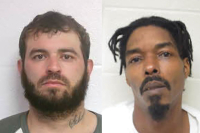Complicated, confusing and utterly fascinating
 I am intimidated by this book. In fact, this is one of the most challenging reviews that I have ever undertaken.
I am intimidated by this book. In fact, this is one of the most challenging reviews that I have ever undertaken.
Admittedly, I have known about David Mitchell, the English “wanderkind” for several years now, but I have carefully avoided any of his five previous novels because they were invariably described as “recklessly ambitious” and filled with sudden shifts (from fantasy to distopian novel to a kind of ecological thriller).
Frankly, I felt that I didn’t have sufficient knowledge to deal with novels that not only had multiple themes and more characters than a Russian novel, but also frequently strayed into alternate universes. Well, I changed my mind after watching the filmed version of Mithcell’s last novel, Cloud Atlas several times. The same complexities and multi-layered plots that have become David Mitchell trademarks abound, but they also have the ability to tempt or entice. So, I have read The Bone Clocks .. .or perhaps I should say I have been “exposed to” the pages of this novel. I have read (and re-read) hundreds of passages and there is much that still bewilders me, but here goes.
The Bone Clocks is composed of six parts and each represents a different aspect in the life of the appealing protagonist, Holly Sykes. We first meet her in 1984 as a 15-year-old runaway in the town of Gravesend, Kent, England. Holly has had a violent disagreement with her mother regarding her night-time activities (she stays out all night). Being both spunky and defiant, Holly decides to move in with a motorcycle-riding boyfriend who turns out to be a treacherous sneak. Rather than return home, contrite and subdued, Holly decides to keep going deep into the country where many young people find work at farms and vineyards.
At this point, Holly’s adventure resembles an episode in Alice in Wonderland as she encounters a series of quaint and bizarre characters. However, these meetings become increasingly sinister. First, there is Ester Little, an old lady fishing on a pier (who asked Holly for “asylum” — a request does not make sense until the end of this novel), and a young man named Ed Brubeck who becomes a kind of self-appointed protector. Then, events acquire a kind of inexplicable terror when a pale man named Rhimes appears and promises Holly a “painless death” if she answers his questions. (Rhimes is searching for Ester Little.) Then, there are the two carefree “hippie-types” who befriend Holly and then suddenly, thanks to Mr. Rhimes, they are ... dead.
What is going on here? Where did we cross a boundary between what appeared to be a Candide-like trek through Margaret Thatcher England into an other-worldly thriller dominated by two warring forces call “atemporals,” that have been battling for thousands of years. They consist of two kinds: the Anchorites (which are unspeakably evil and cannibalistic) and the Horologists (who are essentially benign but outnumbered). There are only seven of them, but they have the capacity to “absorb” the souls and talents of others, storing them for thousands of years ... until they are needed.) Confusing? Well, it’s all just begun.
Related Items
Holly Sykes is the central character in The Bone Clocks and regardless of the complexities attending the epic struggles of the atemporals, she remains the most appealing character in this novel. She is also the most important. As a child, she is troubled by what “voices,” or what she calls “the radio people.” For whatever reason she is a kind of lightning rod for the atemporals. A physician manages to erase the voices (he is an Horologist in disguise) and for a time Holly’s life appears normal, but such is not the case. The old lady fishing on the pier who asked Holly for asylum turns out to be another Horologist and er request is essential to the conclusion of this novel. For most of Holly’s life she carries Ester Little “within her.” Holly doesn’t know it, of course, for Ester has the power to “erase” Holly’s memory.
During the course of her life, Holly meets more fascinating characters. There is Alex Lamb, a slick libertine who seduces her at a ski resort. (Hugo is also an especially vicious Anchorite who enjoys acquiring the form of a mortal in order to sample “earthly delights,” music, wine and Holly, for example.) Then comes Ed Brubeck, the young man Holly first met when she ran away from home. Holly marries Ed and they have two children and life is good until Ed becomes a “warzone junkie” and spends much of his time obsessing about peace and justice in Baghdad. He dies when a drive-by bomb goes off.
Along the way, Holly develops cancer, writes a book about “the radio people” and ends up doing an international book tour. Her book is perceived as a profound insight into the millions of troubled psyches who feel that in some sense, there lives are not their own.
At this point, Holly meets and befriends the most interesting character in The Bone Clocks ... Chrispen Hershey, the “wild child of English literature” who has spent much of his life in a bitter feud with an English critic, Richard Cheeseman, who writes wickedly humorous reviews of Hershey’s work. Lonely and unable to retain a relationship with his women, Hershey become a part of a grueling series of book festivals in Russia, Sweden and Japan where he meets Holly Sykes. He also develops a revenge plot that will put Cheeseman in prison (it works) and leaves the unhappy Hershey guilt-ridden. He is also followed by a stalker ... one that will eventually end his life. In my opinion, this section is beautifully written. Hershey’s relationship with Holly is touching; however, it is a friendship, not a sexual affair. The feud between Cheeseman and Hershey is one of the funniest narratives I have ever read. It is reminiscent of a similar feud in the film version of Cloud Atlas.
For me, the section dealing with the “final conflict” is the most challenging part of this novel. This is the culmination of the war between the Anchorites and the Horologists. It is also filled with terms like redacted, subreplied ,inoculated, metalives, psycho-decanter, ontologize, suasion, etc. All of these terms have to do with how the Anchorites and the Horologists manage to live among us. My spell-checker says that many of them are not words at all!
As for the great battle, I’m not sure who won or why. Who are the “bone clocks”? Well, I can tell you that. This is the term that the atemporals use for humans — we frail mortals that live briefly and comprehend little about the world around. However, the semi-immortal atemporals can only make their own schemes a reality by manipulating the unsuspecting bone clocks. (I hope that made sense.) I am still confused about what happened to Jacko, Holly’s brother. Did the Anchorites kill him, absorb him or is he in hiding? Beats me.
The final section of The Bone Clocks is narrated by the adorable Holly Sykes. The year is 2043. Holly is living on the west coast of Ireland as the world winds down. This is the time called “The Endarkenment.” All of the animals are gone now (elephants, whales, tigers, etc.) and the world is in the grip of final disasters: famine, storms, and roving bands of terrorists. Despite the dark prospects, Holly and her friends are happy and content as they barter for food and revert to a feudal state. Now, deep into the “final days,” Holly and her faithful dog watch the darkness come. It seems to be an old story. The barbarians are at the gates again. Holly has two cyanide pills in her pocket.
Despite the problems that I had with this complex, multi-layered book, I loved it.









